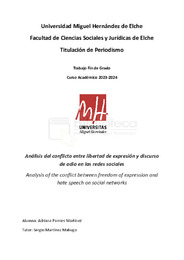Resumen :
Las redes sociales llegaron al mundo para quedarse y revolucionarlo. En la actualidad, son la
mayor herramienta de comunicación y han conseguido facilitar muchas de las tareas
comunes, pues estas no entienden de barreras geográficas y ni temporales. Son un punto
positivo para todo aquel que sepa utilizarlas y en ellas se ejerce el derecho a la libertad de
expresión, pero su mal uso y el traspaso de los límites en los que se atenta contra el derecho
al honor, a la intimidad y a la propia imagen, es el causante que lo que hoy en día
conocemos como ‘ciberacoso’. Según el artículo ‘Being a cybervictim and a cyberbully – The
duality of cyberbullying: A meta-analysis’ de Raquel Lozano-Blasco, Alejandra Cortés y Pilar
Latorre; el 33% de los jóvenes de todo el mundo sufre acoso online1 y, según Statista, el 38%
de los usuarios en la red observa diariamente casos de este tipo en las redes2. Un problema
que, trasladado a los menores de edad, se ha convertido en una denuncia por parte de
fundaciones como ‘Bullying Sin Fronteras’, ‘Fundación ANAR’ o ‘ConRed’.
El presente Trabajo Fin de Grado pretende conocer en qué estado se encuentran las redes
sociales en la actualidad y todo lo que ocurre en ellas, cómo están vistas ante la ley y de qué
forma actúa ésta frente a las acciones de los diferentes usuarios, y entender bien el
ciberacoso en ellas y cómo está visto en por la sociedad.
Además, con el fin de lograr la mayor exactitud en el estudio, se ha llevado a cabo una
metodología mixta combinando las entrevistas al periodista y escritor Basilio Baltasar, a la
doctora en Derecho y Licenciada en Comunicación Audiovisual Elisa Gutiérrez García, y a la
psicóloga clínica María Soledad Espinosa Carreño como parte de la metodología cualitativa;
con una encuesta a 100 personas, formadas por 52 mujeres y 48 hombres, de diferentes
edades, para su posterior análisis.
La encuesta ha sido realizada a través de la herramienta de Formularios de Google, en la que
los encuestados han respondido a 26 preguntas acerca de su visión sobre diferentes
aspectos de las redes sociales.
Social networks came to the world to stay and revolutionize it. Currently, they are the
greatest communication tool and have managed to facilitate many community tasks, since
they do not understand geographical or temporal barriers. They are a positive point for
anyone who knows how to use them and in them the right to freedom of expression is
exercised, but their misuse and the crossing of the limits in which the right to honor, privacy
and one's own freedom are violated. image, is the cause of what we know today as
'cyberbullying'. According to the article 'Being a cybervictim and a cyberbully – The duality of
cyberbullying: A meta-analysis' by Raquel Lozano-Blasco, Alejandra Cortes and Pilar Latorre;
33% of young people around the world suffer online harassment and, according to Statista,
38% of online users observe cases of this type on the networks daily. A problem that, when
transferred to minors, has become a complaint by foundations such as 'Bullying Sin
Fronteras’, 'Fundación ANAR’ or 'ConRed'.
The Final Degree Project aims to know what state social networks are in at present and
everything that happens in them, how they are seen before the law and how it acts against
the actions of the different users and understand well the cyberbullying in them and how it
is viewed by society.
Furthermore, to achieve the greatest accuracy in the study, a mixed methodology has been
carried out combining the interviews of the journalist and writer Basilio Baltasar; the doctor
in Law and Graduate in Communication Elisa Gutiérrez García; and the clinical psychologist
María Soledad Espinosa Carreño; as part of the qualitative methodology, with a survey of
103 people of different ages, for subsequent analysis.
|
 La licencia se describe como: Atribución-NonComercial-NoDerivada 4.0 Internacional.
La licencia se describe como: Atribución-NonComercial-NoDerivada 4.0 Internacional.
.png)
